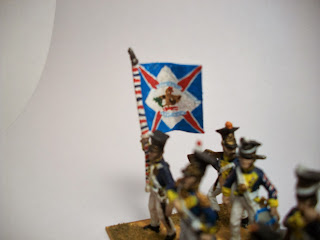Hello everyone!
Over the past couple of days I've been working on some of the new 1/72 Poles that I recieved over the last week. Since I'm a sucker for painting new stuff, I finished up the command stand of the 1e Régiment de la Légion de la Vistule, the start of my first foreign regiment of Napoleon's Army. The Grande Armee included 95,000 Poles, the highest number of foreign troops in French service during the Napoleonic Wars, behind the troops from countries that had been directly annexed by France.
(Remember to click on the pictures for bigger versions.)
These are a mix of 1/72 figures by Strelets-R and Waterloo 1815, with the standard bearer and the drummer being from Waterloo 1815 and the rest from Strelets-R. One of my favorite things about this stand (and something that I did not plan at all when I chose the figures for this base) is the man with his rifle resting on his shoulder in the back rank. His pose, with his left hand outstreched and looking to his left, suggests that he is checking the alignment of the regiment and keeping the musicians in line, an important task for NCOs during the Napoleonic Wars. While I didn't paint rank on him, his pose struck me as being indicitive of the qualities of a good NCO, and I have therefore made him an honorary sergeant.
The flag was made using standard paper fixed and hardened with super glue and then painted free-hand. This was made more difficult because this standard-bearer, from Waterloo 1815, originally came with a cast flag, which I had to carefully remove from the pole with an X-acto knife. I was able to keep the finial, which is a Polish Eagle, not the standard French Eagle. Little details like this really bring out the authenticity of wargame units.
 |
| Here's a detail of the flag; compare to the picture in my last post. |
Even though these lads are more than a head taller than my other 15mm battalions, I based them on thin plasticard so that they would stand shorter on the table; in fact, the tops of their heads are at the same height as the tops of the shako plumes of my AB grenadiers. Also, I was relieved that I was able to fit all six figures on the standard infantry base (4cm by 4cm) without a hitch.
Coming up: I am right now working on another stand of the 19e. They will probably be the next stand I complete. Probably...
Questions, comments and criticisms are always welcomed and appreciated. Thanks for looking!
-Chuck




No comments:
Post a Comment